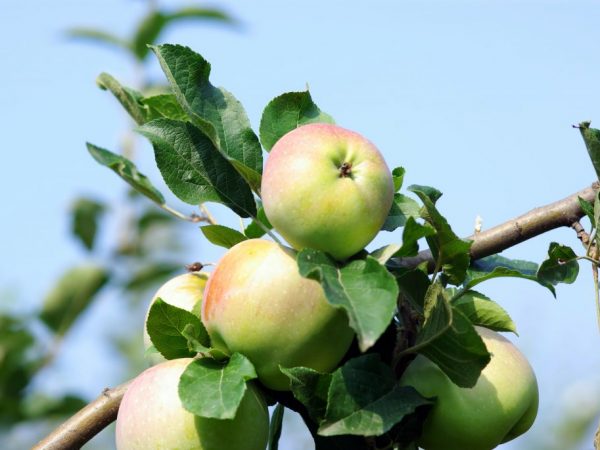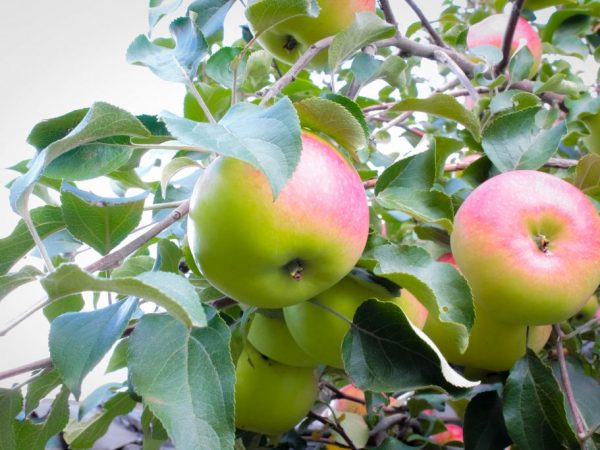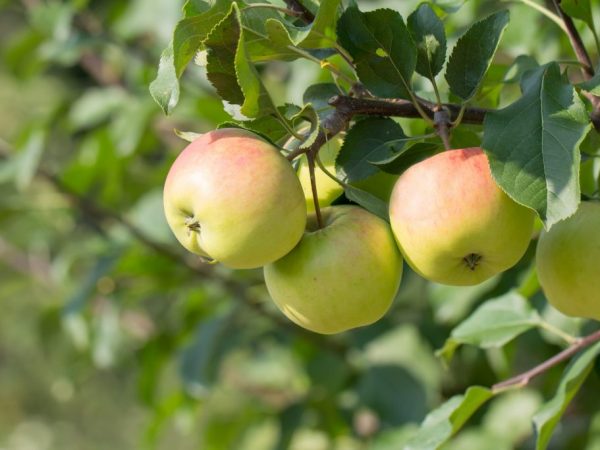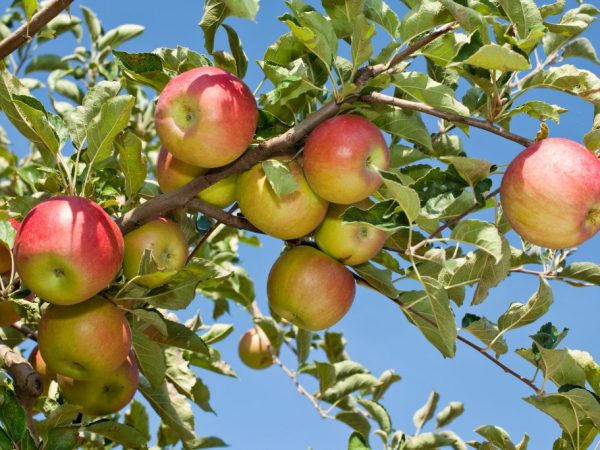Apple variety Imrus
Apple tree Imrus is a hybrid obtained by crossing Antonovka ordinary with several winter-hardy varieties. The name is an abbreviation of the phrase "Russian immunity", and the variety itself is popular with gardeners for its valuable qualities.
- Variety characteristic
- Description of the tree
- Fruit
- Yield
- Winter hardiness
- Pollinators
- Disease and pest resistance
- Advantages and disadvantages
- Landing features
- Dates and place
- Technology
- Tree care
- Watering and soil cultivation
- Top dressing
- Crown pruning
- Protection against diseases and pests
- Features of ripening and fruiting
- How to harvest and preserve crops
- Subspecies and varieties
- Regional features of cultivation
- Gardeners' reviews about this variety

Apple variety Imrus
Variety characteristic
The breeding work lasted a long time - from 1977 to 1989, and then another 7 years were tested.
As a result, Imrus was entered into the state register and recommended for cultivation in the Central and Central Black Earth regions.
Subsequent practice has shown that the tree can be grown in other conditions, for example, in the south of Siberia.
Description of the tree
Distinctive features of the apple tree of this variety are the rough brown-green bark and the rounded shape of the spreading and rather dense crown. Only with age does this green tint disappear.
Standard trees, and if they are formed from seed stock, they can reach up to 6 m in height. With a dwarf rootstock (that is, obtained from a cuttings), the height is less, up to 3 or 4 m.
The branches are elastic and relatively thin. Leaves are oblong with a twisted tip, petiolate. From above, the leaves are smooth and green, their surface looks crumpled due to the numerous veins. The edges are jagged.
Early flowering, beginning in May. The flowers are small, white-pink, collected in inflorescences of 5 or 6 pieces.
Important characteristics include:
- annual growth (about 10 cm);
- tree life: with a seed stock, a tree lives up to 80 years, with a clone stock - much less.
Fruit
The Imrus apple reaches maturity by the end of September.
Fruits are yellow-green with a blush, medium size, weight from 130 to 180 g, slightly flattened shape. The peel is thin, easily damaged, somewhat oily to the touch.
The pulp is very juicy, dense, greenish-creamy, pink blotches are possible. The structure is fine-grained. Sour-sweet taste, pronounced aroma.
Composition

Apples contain many nutrients
Apples contain:
- vitamins (C, A, E, K, B1, B2, B3, B5, B6, B9);
- minerals (iron, copper, zinc, potassium, calcium, magnesium, sodium, phosphorus);
- pectins;
- organic sugars;
- organic acids;
- vegetable protein;
- unsaturated fatty acids;
- tannins;
- essential oils.
Yield
The first harvest begins to take off at 3-6 years (depending on the type of rootstock). The yield grows from year to year (with proper tree care) and ranges from 30 to 100 kg per year.
Winter hardiness
The tree tolerates cold and even snowless winters, as well as early frosts.
Still, it is better to prepare them for winter: cover the trunks with a thick layer of humus, wrap the trunks with burlap, and cover them with spruce branches below (this is also protection from rodents).
Pollinators
According to the description, Imrus is pollinated by insects, but the apple tree is considered only partially self-fertile and needs pollinators to bloom with it at the same time (for example, Freshness, Veteran, Kandil Orlovsky, etc.).
Disease and pest resistance
The cultivar is genetically inherent in resistance to powdery mildew and scab - common fungal diseases of apple trees, which are difficult to control.
However, there is no resistance to other diseases (black cancer, fire blight) and pests (apple sawfly, flower beetle, green aphid). Fortunately, all of these disasters do not threaten apple trees with proper care.
Advantages and disadvantages

The Imrus variety will delight you with its yield
Apple variety Imrus has the following advantages:
- winter hardiness;
- genetic resistance to scab and powdery mildew;
- high productivity;
- excellent taste of the fruit.
The disadvantages include:
- the need to plant pollinators;
- thin peel (if damaged, the fruits will not be stored for a long time).
Landing features
Dates and place
Young apple trees are planted in the spring, at the end of April, or in the fall, at the end of September or in October.
In order for the tree to develop well and subsequently bear fruit abundantly, the seedlings must be located in a place well-lit by the sun and little wind blown. In the selected area, groundwater should not come close to the soil surface.
If the soil is acidic, it needs to be adjusted by liming the pH.
Technology
Prepare a pit for planting in advance. Its diameter is about 80 cm, and its depth is at least 60 cm.
At the chosen place, they dig deeply into the soil. The upper fertile layer is mixed with a bucket of humus, half a bucket of peat and 1 tbsp. nitroammophos.
Fragments of brick or gravel are laid out at the bottom of the pit to ensure good drainage. A layer of soil mixed with fertilizers is poured onto the drainage, a seedling is installed and the roots are covered with the remaining soil.
In its final form, the seedling should be in a shallow hole, and the root collar should be 5-6 cm above the compacted soil.
The soil is covered with layers and each layer is tamped. A peg is also installed in the center of the pit, to which the seedling is tied. After it is generously watered.
Tree care
Watering and soil cultivation

The soil under the trees must be loosened
The first year the seedling is watered as the topsoil dries up. In the subsequent - only in a very hot time and during the formation of kidneys.
Watered in the morning and evening, and not during the sun. Standard: at least 2 buckets of water per day for each tree. Old, sprawling trees require up to 10 buckets per day.
The soil under the tree should be periodically loosened, and any weeds should be weeded out.
It is also recommended to mulch the soil under the apple tree. This protects it from drying out, and in severe weather conditions it also protects the root system from hypothermia.
Top dressing
In the spring, usually from the 3rd year after planting, they are fed with a complex fertilizer, for example, nitroammophos. 1 tbsp fertilizers are diluted in a bucket of water, applied under one apple tree.
In the fall, they feed optionally if the harvest was especially plentiful. One tree is fertilized with a mixture: 0.5 kg of wood ash, 1 tbsp. superphosphate and 1 tbsp. potassium salt.
Crown pruning
Pruning is performed annually, even before bud break, that is, in early spring. This helps to increase the yield and quality of the fruit.
It is necessary to remove branches that thicken the crown and interfere with its uniform illumination. In addition, you need to remove all non-viable (dried out, broken) branches.
Protection against diseases and pests
In the spring, the trunks of apple trees to the point of origin of the lower skeletal branches are certainly whitewashed with lime - this is an effective protection against many pests and fungal spores.
Also, to protect against moth caterpillars, trees are supplied with trapping belts.
You need to regularly inspect apple trees for damage and the presence of pests. If damaged branches or bark are seen, the foci are treated with disinfectants. This is the best prevention of developing black cancer or fire blight.
- Regular digging of soil around the trees will protect against the apple sawer.
- Frequent spraying with infusion of dandelion roots or tobacco helps with aphids.
- The prevention of pest damage is also considered to be timely cleaning of fallen leaves.
Features of ripening and fruiting
Fruiting begins at different ages, depending on the rootstock. With a clone - in the third year, and with a seed - by 5 or 6. As already emphasized in the description of the variety, the yield increases from year to year.
Imrus is an autumn variety. Apples ripen by the end of September. Some of them fall off the tree spontaneously. Therefore, it is undesirable to postpone harvesting.
Fruiting is annual, but if autumn fertilization is neglected for several years, with a bountiful harvest, the yield may decrease.
How to harvest and preserve crops

The fruits must be carefully removed from the tree.
It is more correct to pick apples while they are green. During subsequent storage, they turn yellow.
Plucked ripe fruits are stored until February. It is not recommended to throw the plucked fruits, you need to carefully put them in a collection container.
The fruits are stored in ventilated wooden boxes in a dark, cool room (basement), preferably separately from other vegetables. Neighborhood with apples has a bad effect on the preservation of potatoes: they germinate faster. This happens from the release of ethylene gas.
The harvested fruits tolerate transportation well, if you do not shake or throw boxes during loading and unloading.
Subspecies and varieties
There are several varieties of a rather exotic species: columnar, dwarf and semi-dwarf.
Column-shaped trees are devoid of branchy lateral branches. However, the harvest is plentiful and easier to harvest than from a spreading tree.
Dwarf and semi-dwarf trees are low, but with high yields. They require special care, many props, and their lifespan is no more than 10 years.
Regional features of cultivation
The variety is ideal for regions with a temperate continental climate, for example, for the Moscow region.
This is not surprising: it was bred precisely for such climatic conditions. It is recommended to insulate the trunk and root soil for the winter.
The same can be said about preparing apple trees for winter in southern Siberia. There is information about their cultivation even in the south of the Krasnoyarsk Territory. The climate in this area is sharply continental, and, in addition to the winter cold, the trees have to go through a sultry summer. Watering should be adequate.
In the Leningrad region, this variety takes root, but with difficulty, because the soils are scarce. But enthusiasts still get crops by artificially enriching the soil.
In Belarus, Imrus has long been zoned in many regions; apple trees grow and bear fruit very well here.
Gardeners' reviews about this variety
Hybrid variety Imrus is ideal for the climatic conditions of many regions.
Resistance to the most unpleasant fungal infections of apple trees, winter hardiness, high yield, the possibility of long-term storage of fruits make it especially attractive for gardeners, including those who do not have much experience.
At the same time, in order to bear fruit abundantly, trees need simple but proper care throughout their entire life cycle.

